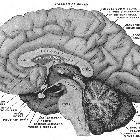Foramen interventriculare Monroi






The interventricular foramen, also known as foramen of Monro, is part of the ventricular system and the connection between the third ventricle and the lateral ventricle.
These paired foramina allow for the flow of cerebrospinal fluid between lateral ventricles and third ventricle, and effacement or blockage results in non-communicating obstructive hydrocephalus.
Gross anatomy
Each foramen of Monro lies between the roof and anterior wall of the third ventricle behind the column and body of the fornix and anterior to the thalamus .
A number of structures pass through each foramen (in addition to CSF) :
- choroid plexus
- arteries: distal branches of the medial posterior choroidal arteries
- veins: thalamostriate, superior choroidal and septal
If the ventricles are small, then each foramen is a small crescent, concave anteriorly (indented by the fornix). On the other hand, if the ventricles are large, each foramen becomes more circular in crosssection .
History and etymology
The structure was named after the Scottish physician Alexander Monro (1733-1817), who first described it in 1783 . It should be noted, however, that in his description he acknowledges that these communications were known about and previously described as far back as Galen, and this is another example of Stigler law of eponymy .
To be precise, it should also be noted that the individual who described the foramen is Alexander Monro secundus (the second). His father and his son were both also called Alexander Monro (primus and tertius respectively) and all three of them held the chair of anatomy at the University of Edinburgh .
Related pathology
Siehe auch:
- dritter Ventrikel
- Seitenventrikel
- Verschlusshydrocephalus
- Hirnventrikel
- Kolloidzyste des dritten Ventrikels
- subependymales Riesenzellastrozytom
- Stenose des Foramen Monroi
und weiter:

 Assoziationen und Differentialdiagnosen zu Foramen interventriculare Monroi:
Assoziationen und Differentialdiagnosen zu Foramen interventriculare Monroi:





